OREGON
SUNSTONE
Prior to the finds
of substantial amounts of facetable plagioclase feldspar crystals in
Oregon, most sunstone, much of which came from India, was opaque and
used for cabbing, bead, or carving material. Such is the case no
longer. An incredible variety of high value sunstone rough is now
being extracted by several mining companies as well as on public
collecting sites in Oregon. Although most of the rough is pale yellow
in color, a substantial amount of more interesting material is being
found. Two main features are notable in high value rough collected
from this location: 1) strong body colors ranging from pinks and tans
to oranges, greens and reds as well as bi- and tri-colors, and 2)
fine grained coppery shiller which allows for transparency in the
stone yet still produces the phenomenon of aventurescence or
"glitter". Every combination of shiller or lack of it, and color is
found.
Collectors and
jewelry lovers from all over the world are fast becoming aware of
this uniquely American gemstone and appreciate it as one of the
shrinking number of materials that can be correctly assumed to be
completely untreated and unenhanced.
As with other
feldspar gems, gentle treatment and protective settings are called
for, and use in everyday rings is not advisable. To date there are no
synthetics in the market.
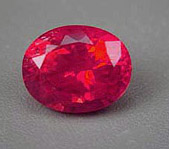
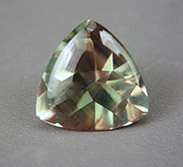
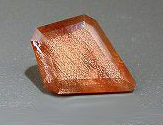
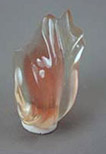
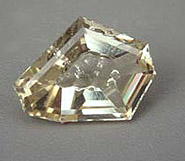 [Oregon
sunstones: red, green (slight bi-color), shiller, bi-colored carving,
pale yellow fantasy cut stone]
[Oregon
sunstones: red, green (slight bi-color), shiller, bi-colored carving,
pale yellow fantasy cut stone]
Value
Because there are so many different
kinds of sunstone, the values range widely. The least valuable form
is the pale yellow to colorless non-shiller type which in commerical
cut, or calibrated stones may go for a few dollars per carat, and for
custom cut stones somewhat more. The pinks and tans with and without
shiller have additional value, depending on the color and effect.
Some greens, strong pinks and reds as well as the bicolored and
tricolored stones with and without shiller are much more valuable.
The most desirable color is red with large (over 3 carat) stones of
prime color retailing at prices rivaling fine sapphires and emeralds.
The best greens are very rare and can cost more than the best reds.
Oregon sunstone, especially shiller or bi-color pieces are often used
for fine art carving material; and the carvings are valued as much
for their artistic merit (and the fame of the artist) as for the
value of the material itself.
Gemological
Data
Makeup: a calcium rich
species of plagioclase feldspar,
sometimes with copper or
hematite inclusions and traces of iron; 32% Albite, 68%
Anorthite
Luster: Vitreous
Hardness: 6 - 6.5
Cleavage: 2, Perfect
Fracture: splintery to
uneven
Density: 2.70
RI: 1.56 - 1.57









